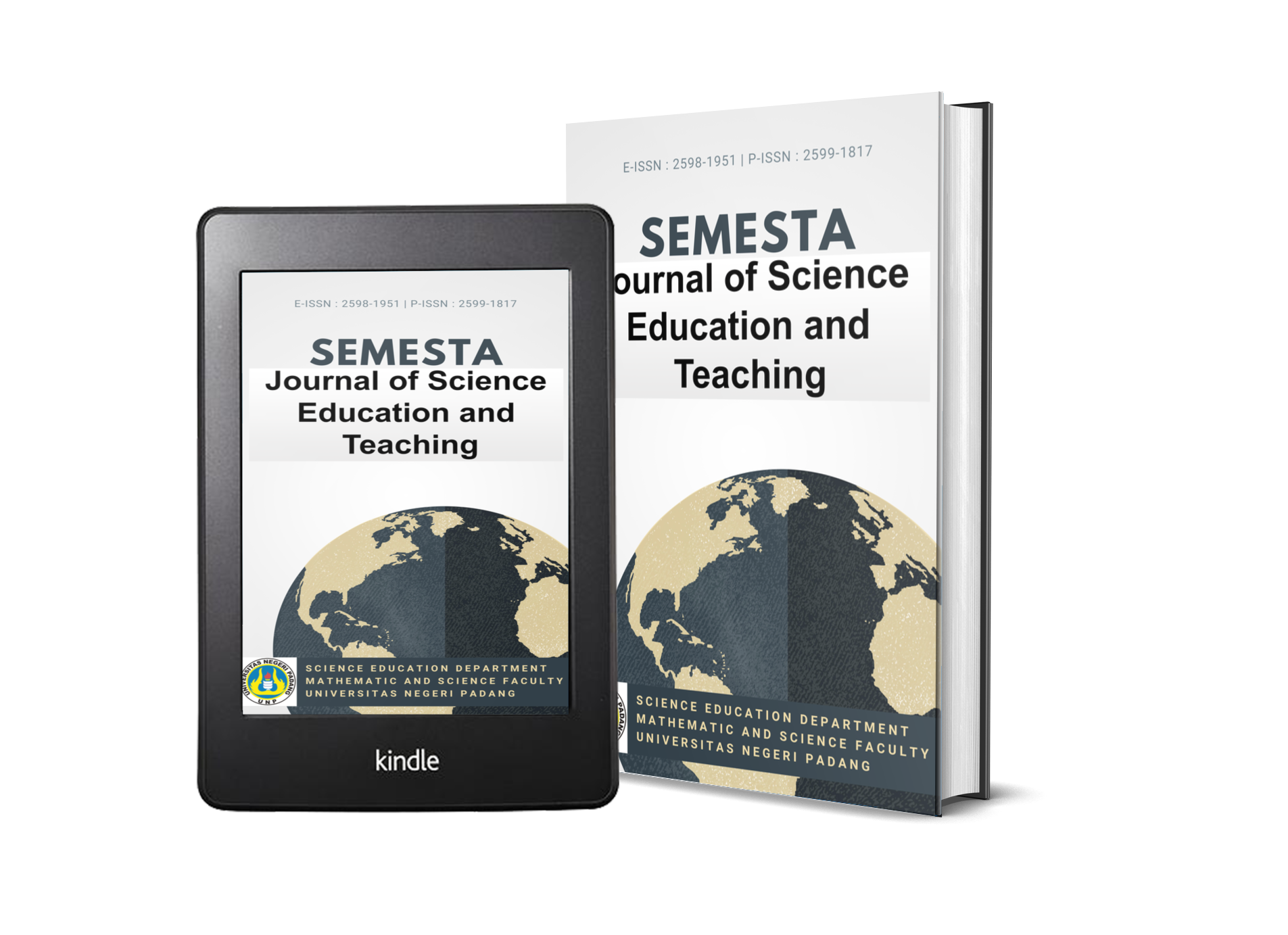LITERATURE STUDY: STUDENTS' CURIOSITY ABOUT STEM-PBL MODEL IN SCIENCE CLASSROOM
DOI:
https://doi.org/10.24036/semesta/vol7-iss1/278Keywords:
STEM, Problem Based Learning, Students CuriosityAbstract
Problem Based Learning (PBL) is a form of problem-based learning that is given to students to apply knowledge to issues or problems as a form of problem solving. Its integration with the STEM (Science, Technology, Engineering, and Mathematics) approach can train students to apply their knowledge in making designs as a form of problem solving related to the environment using technology. The purpose of writing this article is to find out the improvement, response and impact of students' curiosity by using the STEM-PBL learning model in science class. The method used is content analysis, with the principles of Preferred Reporting Items For Systematic Reviews and Meta Analysis (PRISMA). Based on the results of this study, it shows that students' curiosity towards STEM PBL in science classes shows significant results overall because the application of hands-on activities as a learning strategy is able to form various skills and provide positive results and even increase.
References
Adelita, Tiara, Tatang Suhery, and Arif Ibrahim. 2017. “Pengembangan Strategi Pembelajaran Dengan Pendekatan Stem – Problem Based Learning Pada Materi Laju Reaksi Di Kelas XI Sma.” Jurnal Penelitian Pendidikan Kimia : Kajian Hasil Penelitian Pendidikan Kimia 4(2): 105-110.
Afriana, Jaka, Anna Permanasari, and Any Fitriani. 2016. “Penerapan Project Based Learning Terintegrasi STEM Untuk Meningkatkan Literasi Sains Siswa Ditinjau Dari Gender.” Jurnal Inovasi Pendidikan IPA 2(2): 202.
Apriyani, Rany, Taufik Ramlan Ramalis, and Irma Rahma Suwarma. 2019. “Analyzing Student’s Problem Solving Abilities of Direct Current Electricity in STEM-Based Learning.” Journal of Science Learning 2(3): 85–91. http://ejournal.upi.edu/index.php/jslearning/article/view/33.
Arnawa, I.K. 2021. “Penerapan Model Pembelajaran Berbasis Masalah Dengan Metode Tutor Sebaya Untuk Meningkatkan Hasil Belajar Siswa.” Wahana Matematika dan Sains: Jurnal Matematika, Sains, dan Pembelajarannya 15(1): 69–80.
Arnone, Marilyn P., Ruth V. Small, Sarah A. Chauncey, and H. Patricia McKenna. 2011. “Curiosity, Interest and Engagement in Technology-Pervasive Learning Environments: A New Research Agenda.” Educational Technology Research and Development 59(2): 181–98.
Asghar, Anila et al. 2012. “Supporting STEM Education in Secondary Science Contexts.” Interdisciplinary Journal of Problem-Based Learning 6(2).
Boelt, A. M., A. Kolmos, and J. E. Holgaard. 2022. “Literature Review of Students’ Perceptions of Generic Competence Development in Problem-Based Learning in Engineering Education.” European Journal of Engineering Education (May).
Cahyaningsih, Febriana, and Ir Ekosari Roektiningroem. 2018. “Pengaruh Pembelajaran IPA Berbasis STEM-PBL Terhadap Keterampilan Berpikir Kritis Dan Hasil Belajar Kognitif.” E-Journal Pendidikan IPA 7(5): 239–44.
Çalışıcı, Sinan, and Semra Benzer. 2021. “The Effects of Stem Applications on the Environmental Attitudes of the 8Th Students, Scientific Creativity and Science Achievements.” Malaysian Online Journal of Educational Sciences 9(1): 24–36. http://mojes.um.edu.my/EISSN:2289-3024.
Davidi, Elisabeth Irma Novianti; Sennen, Eliterius; Supardi, Kanisius. 2021. “Intergrasi Pendekatan STEM Untuk Peningkatan Keterampilan Berpikir Kritis Siswa Sekolah Dasar.” Integrasi Pendekatan STEM (Science, Technology, Engineering and Mathematic) Untuk Peningkatan Keterampilan Berpikir Kritis Siswa Sekolah Dasar 11 No. 1: 11–22.
Farwati, Ratna, Anna Permanasari, Harry Firman, and Tatang Suhery. 2018. “Integrasi Problem Based Learning Dalam STEM Education Berorientasi Pada Aktualisasi Literasi Lingkungan Dan Kreativitas.” Seminar Nasional Pendidikan IPA Tahun 2021 1(1): 198–206. http://conference.unsri.ac.id/index.php/semnasipa/article/view/688.
Hite, Rebecca L., and Jill White. 2019. “Balancing Profits and Conservation: A Human Environmental Impact PBL for Upper Elementary and Middle Grades STEM Club Students.” Science Activities 56(3): 88–107. https://doi.org/10.1080/00368121.2019.1693950.
Izzati, Nur, Linda Rosmery Tambunan, Susanti Susanti, and Nur Asma Riani Siregar. 2019. “Pengenalan Pendekatan STEM Sebagai Inovasi Pembelajaran Era Revolusi Industri 4.0.” Jurnal Anugerah 1(2): 83–89.
Kapila, Vikram, and Magued Iskander. 2014. “A. Typical Sensor-Based Experiments.” 15(1): 46–51.
Karakaya, Ferhat. 2020. “Determination of Middle School Students ’ Views.” International Online Journal of Education and Teaching 7(April): 537–51.
Kibga, E S. 2021. “Developing Students’ Curiosity Through Chemistry Hands-on Activities: A Case of Selected Community Secondary Schools in Dar Es Salaam, Tanzania.” Eurasia Journal of Mathematics, Science and Technology Education 17(5): 1–17.
Kibga, Esther Samwel, Emmanuel Gakuba, and John Sentongo. 2021. “Mengembangkan Keingintahuan Siswa Melalui Kegiatan Praktek Kimia : Kasus Sekolah Menengah Komunitas Terpilih Di Dar Es Salaam , Tanzania.” 17(5).
MacFarlane, David W., and Aaron R. Weiskittel. 2016. “A New Method for Capturing Stem Taper Variation for Trees of Diverse Morphological Types.” Canadian Journal of Forest Research 46(6): 804–15.
Mahmudi, Ali. 2006. “Pembelajaran Kolaboratif [Collaborative Learning].” Pembelajaran Kolaboratif: 1–11. http://eprints.uny.ac.id/11996/1/PM - 57 Ali Mahmudi.pdf.
Maryati, Iyam. 2018. “Penerapan Model Pembelajaran Berbasis Masalah Pada Materi Pola Bilangan Di Kelas Vii Sekolah Menengah Pertama.” Mosharafa: Jurnal Pendidikan Matematika 7(1): 63–74.
Muttaqiin, Arief. 2023. “Pendekatan STEM (Science, Technology, Engineering, Mathematics) Pada Pembelajaran IPA Untuk Melatih Keterampilan Abad 21.” Jurnal Pendidikan Mipa 13(1): 34–45.
Nur Kholifah, Ika, Al Maryanto, and Dan Eko Widodo. 2018. “Pengaruh Pembelajran IPA Berbasis STEM Terhadap Sikap Ingin Tahu Dan Keterampilan Berpikir Kreatif Peserta Didik.” E- Jurnal Pendidikan 7(3): hal.129.
Oktaviani, Winda, Faizal Chan, Dwi Kurnia Hayati, and Akhmad Syaferi. 2021. “Meningkatkan Rasa Ingin Tahu Siswa Pada Pembelajaran IPA Melalui Model Discovery Learning.” Al Jahiz: Journal of Biology Education Research 1(2): 109.
Oudeyer, P. Y., J. Gottlieb, and M. Lopes. 2016. 229 Progress in Brain Research Intrinsic Motivation, Curiosity, and Learning: Theory and Applications in Educational Technologies. 1st ed. Elsevier B.V. http://dx.doi.org/10.1016/bs.pbr.2016.05.005.
Qomariyah, Evi Nurul. 2017. “Pengaruh Problem Based Learning (PBL) Terhadap Kemampuan Berpikir Kritis IPS.” Jurnal Pendidikan dan Pembelajaran 23(2): 132–41.
Suhirman, S., Saiful Prayogi, and Muhammad Asy’ari. 2021. “Problem-Based Learning with Character-Emphasis and Naturalist Intelligence: Examining Students Critical Thinking and Curiosity.” International Journal of Instruction 14(2): 217–32.
Tagliabue, Giulia et al. 2021. “No Title.” Journal of Photogrammetry and Remote Sensing 187: 362–77.
Xu, Weiqi, and Fan Ouyang. 2022. “The Application of AI Technologies in STEM Education: A Systematic Review from 2011 to 2021.” International Journal of STEM Education 9(1).
Zion, Michal, and Lrit Sadeh. 2007. “Curiosity and Open Inquiry Learning.” Journal of Biological Education 41(4): 162–69.

Downloads
Published
How to Cite
Issue
Section
License
Copyright (c) 2024 Dara Adinda Putri, Fathia Zahra

This work is licensed under a Creative Commons Attribution 4.0 International License.





